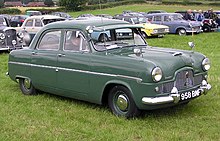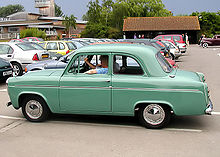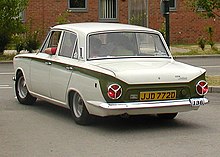Ford of Britain
| Ford Motor Company
|
|
|---|---|
| legal form | Limited |
| founding | 1909 as Ford Motor Company (England) Ltd. |
| resolution | 1967 |
| Seat | Brentwood (Essex) , United Kingdom |
| management |
|
| Branch | Automobile manufacturer |
| Website | www.ford.co.uk |
The Ford Motor Company Limited was a British automobile manufacturer from 1909 to 1967, first in London and then in Dagenham (Essex) and Brentwood (Essex) was established. The company was the British branch of the US automobile manufacturer Ford Motor Company . She was responsible for the manufacture and sale of Ford products in the United Kingdom and initially in Ireland . In 1967 it was merged with Ford Germany to become Ford of Europe .
history
1903-1918
The first Ford automobiles, three Model A , were introduced to the UK in 1903 and the first Ford dealership opened in Southampton in 1910 . In 1909 the Ford Motor Company (England) Ltd. on Shaftesbury Ave. Founded 55 in London under the leadership of Percival Perry . In 1911, an assembly plant was opened in an old tram factory in Trafford Park, Manchester , where the Model T was assembled by 60 workers . At the same time the company was renamed Henry Ford & Son Ltd. renamed. This was the first Ford factory outside the United States. Initially the cars were assembled on imported chassis, with the bodies coming from local suppliers, but in 1914 the first assembly line was installed in Britain, building 21 cars per hour. 6,000 vehicles were built in 1913 and the Model T became the best-selling car in Great Britain with a 30% market share. After World War I , the Trafford Park plant expanded and in 1919 41% of all cars registered in the UK were Ford.
In 1917 a plant was added in Cork , Ireland, which was originally intended for the construction of tractors, but where cars were also assembled from 1921. This was the first factory building built by Ford in Europe. In 1984 this plant closed.
1918-1939
Although the Trafford Park plant was served by the Manchester Ship Canal , Ford decided that access to a deep water port was essential and in 1923 the decision was made to move to a new plant in Dagenham on the Thames , east of London. Construction began in 1929 and in October 1931 what was then the largest automobile assembly plant in Europe was opened, in which the car model A and the truck model AA were built. This was accompanied by another name change of the company to Ford Motor Company Ltd. It was at the height of the Great Depression and the Model A was too expensive in taxes and maintenance for many British, so that only a few copies could be sold. In the first three months there were only five of them. So the company urgently needed a smaller model, which appeared in model year 1933 as Model Y with 933 cm³ displacement. This car was much better suited to the economic situation at the time and became the first car in Great Britain in 1935 to sell for £ 100 was offered. From 1932 to 1937 over 157,000 were made in Dagenham and Cork and at peak times 41% of all cars sold in this segment of the UK were Ford Model Y. In 1939 tractor production was relocated to Dagenham.
1940-1944
During the Second World War , 360,000 vehicles were built in Dagenham and 34,000 Rolls-Royce Merlin aircraft engines were built under Ford control in a new factory in Urmston (Greater Manchester) .
1945-1967
After the Second World War, civil production was resumed. In 1946 115,000 vehicles were built in Dagenham and the factories in London- Walthamstow and Langley (Buckinghamshire) (later to Berkshire) were built. In 1953 Briggs Motor Bodies was bought, which allowed the company better access to its suppliers and was connected with the purchase of further plants in Doncaster (Yorkshire) , Southampton, Croydon (London) and Romford . In 1953 Ford of Britain had 40,000 employees.
Until 1960 the Ford Motor Company (England) Ltd. a company listed on the stock corporation, but this year joined Ford USA, the minority shareholders ( " squeeze-out ") so that Ford of Britain has been a 100% subsidiary of Ford US.
In 1962, Ford opened a factory near Halewood for the new Anglia . In 2000 Ford gave up this plant with the last Escort , since 2001 the Jaguar X-Type has been built there.
Another new factory was opened in Basildon in 1964, producing tractors , and in 1965 another factory in Swansea for chassis components and axles was added.
commercial vehicles
Ford manufactured a number of commercial vehicles starting with the TT 1917 model . From 1933 to 1939 these vans were called Fordson , from 1939 to 1957 Fordson Thames or Ford Thames and from 1957 to 1965 only Thames . From 1965 they returned to the name Ford . After the Trafford Park plant closed, most of the delivery vans were built in Langley. In 1986 the entire division was sold to the Italian Iveco Group. This is how Iveco-Ford came into being , in which Ford held a 48% stake. The Ford brand name was soon abandoned in Europe for heavy commercial vehicles. Iveco closed the Langley plant in 1997.
Models
Car
- Ford Model T (1913-1927)
- Ford Model A (1928-1931)
- Ford Model B (1932-1935)
- Ford Model Y (1932-1937)
- Ford 7Y (1937-1939)
- Ford V8 (1932-1939)
- Ford Model C Ten (1935-1937)
- Ford 7W (1937-1938)
- Ford Anglia (1939-1967)
- Ford Prefect (1939-1961)
- Ford V8 Pilot (1947–1951)
- Ford Consul (1950–1962)
- Ford Zephyr (1951-1972)
- Ford Zodiac (1954–1972)
- Ford Popular (1953-1962)
- Ford Escort / Squire (1955–1961)
- Ford Consul Classic (1961–1963)
- Ford Consul Capri (1961–1964)
- Ford Cortina (1962-1982)
- Ford Corsair (1963-1970)
- Ford Escort (1968-2000)
- Ford Capri (1969-1986)
- Ford Granada (1972-1994)
- Ford Sierra (1982-1993)
commercial vehicles
(1 cwt = 50.8 kg)
- Fordson tractor (1917-1964)
- Ford model TT 1 to. (1917–)
- Ford model AA 30cwt (1928-)
- Ford Model BB (1932-)
- Ford Model Y 5 cwt (1932-1937)
- Fordson Thames 7V
- Fordson E83W 10cwt panel van and flatbed truck (1938–1957)
- Fordson E04C 5 cwt (1945-1948)
- Fordson E494C 5 cwt (1948–1954)
- Fordson Thames ET6 / ET7
- Ford Thames 300E 5 cwt (1954)
- Ford Thames 400E 10,12,15 cwt
- Ford Thames 307E 5 & 7 cwt (1961-)
- Ford Thames Trader 30 cwt, 2, 3, 4, 5 and 7-ton (1957-1965)
- Ford Transit (1965-)
- Ford D series
- Ford A series
- Ford R series
- Ford Transcontinental (1975-1984)
- Ford Cargo (1981-1993)
Supercar
- Ford GT40 (1966-1968)
Production numbers
A total of 24,321,719 vehicles were built between 1903 and 2002 . This number includes passenger cars , passenger-derived vans, and commercial vehicles.
Below is a list of car production.
| year | Production number |
|---|---|
| 1911 | 1,485 |
| 1912 | 2,942 |
| 1913 | 6.138 |
| 1914 | 8,242 |
| 1915 | 8,905 |
| 1916 | 9,037 |
| 1917 | 4,268 |
| 1918 | 2,527 |
| 1919 | 8,086 |
| 1920 | 25,666 |
| 1921 | 11,603 |
| 1922 | 11.091 |
| 1923 | 11,507 |
| 1924 | 8,919 |
| 1925 | 5,086 |
| 1926 | 4,510 |
| 1927 | 1,817 |
| 1928 | 2,896 |
| 1929 | 7.120 |
| 1930 | 4,495 |
| 1931 | 5 |
| 1932 | 11,920 |
| 1933 | 36,424 |
| 1934 | 34,486 |
| 1935 | 48,551 |
| 1936 | 74,988 |
| 1937 | 77,830 |
| 1938 | 59,935 |
| 1939 | 48,031 |
| 1940 | 11,286 |
| 1941 | 2,885 |
| 1942 | 5,162 |
| 1943 | 2,647 |
| 1944 | 1,165 |
| 1945 | 2,330 |
| 1946 | 33,945 |
| 1947 | 44,849 |
| 1948 | 66,560 |
| 1949 | 79,448 |
| 1950 | 99,478 |
| 1951 | 94,268 |
| 1952 | 93,858 |
| 1953 | 160,575 |
| 1954 | 210.153 |
| 1955 | 241.502 |
| 1956 | 227.209 |
| 1957 | 241,950 |
| 1958 | 289,922 |
| 1959 | 319.454 |
| 1960 | 407,548 |
| 1961 | 326,927 |
| 1962 | 368,459 |
| 1963 | 504.093 |
| 1964 | 526.041 |
| 1965 | 505.168 |
| 1966 | 465.309 |
| 1967 | 440.712 |
| 1968 | 498.100 |
| 1969 | 541.123 |
| 1970 | 462,893 |
| 1971 | 368,482 |
| 1972 | 537.722 |
| 1973 | 453,448 |
| 1974 | 383.724 |
| 1975 | 333,557 |
| 1976 | 387,309 |
| 1977 | 421,769 |
| 1978 | 327,398 |
| 1979 | 408.726 |
| 1980 | 342,756 |
| 1981 | 342.176 |
| 1982 | 307,640 |
| 1983 | 318,686 |
| 1984 | 273,767 |
| 1985 | 317,689 |
| 1986 | 346.266 |
| 1987 | 383.429 |
| 1988 | 374,462 |
| 1989 | 382,595 |
| 1990 | 329,604 |
| 1991 | 339.182 |
| 1992 | 302.990 |
| 1993 | 261,546 |
| 1994 | 269.050 |
| 1995 | 274,367 |
| 1996 | 318,250 |
| 1997 | 302.406 |
| 1998 | 298,629 |
| 1999 | 255.125 |
| 2000 | 155.094 |
| 2001 | 73.180 |
| 2002 | 12,903 |
| total | 18,017,816 |
Note: The individual numbers add up to 18,017,456.
literature
- David Culshaw, Peter Horrobin: The Complete Catalog of British Cars 1895-1975. Veloce Publishing PLC, Dorchester, 1997; ISBN 1-874105-93-6 .
- Jonathan Wood: The British Motor Industry. Shire Publications Ltd, 2010; ISBN 0-7478-0768-X .
- GN Georgano (Ed.), G. Marshall Naul: Complete Encyclopedia of Commercial Vehicles. MBI Motor Books International, Osceola WI, 1979; ISBN 0-87341-024-6 .
- Halwart Schrader , Jan P. Norbye: The truck lexicon. All brands 1900 to today. Schrader Verlag, Stuttgart 1998, ISBN 3-613-01837-3 .
- lastauto omnibus commercial vehicle catalog 1980. All commercial vehicles, trailers, bodies, crane trucks, loading aids in Germany United Motor-Verlage Stuttgart 18372.
Web links
- Ford of Britain (English)
- Early documents and newspaper articles on the Ford of Britain in the 20th century press kit of the ZBW - Leibniz Information Center for Economics .
Individual evidence
- ↑ History of Ford Europe (English) ( Memento of the original from August 9, 2011 in the Internet Archive ) Info: The archive link was automatically inserted and not yet checked. Please check the original and archive link according to the instructions and then remove this notice.
- ↑ Maurice A. Smith (Ed.): American Paentage . Autocar, issue 128 (nr 3766) of April 18, 1968. p. 64.
- ^ A b Hubert Bonin, Yannick Lang, Steven Tolliday: Ford. The European History 1903-2003. Plage, 2003, ISBN 2914369069 .







